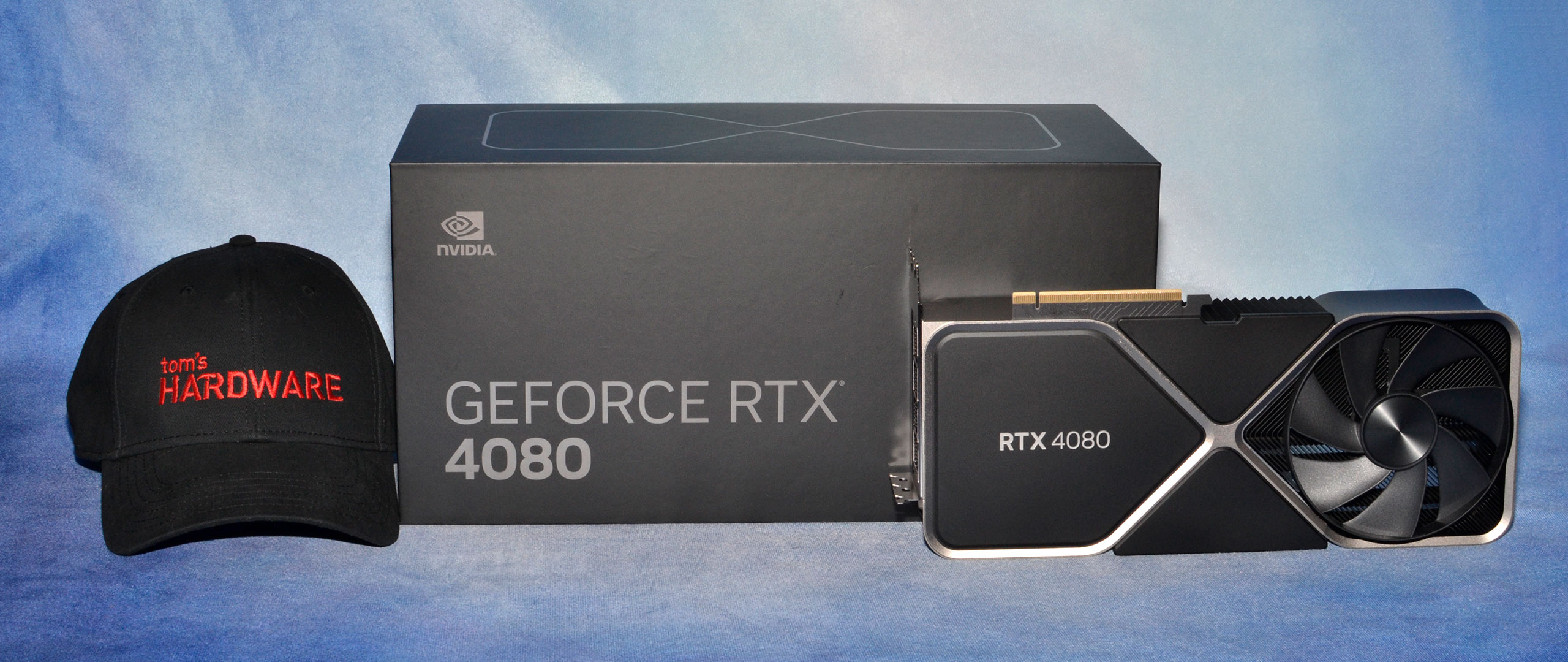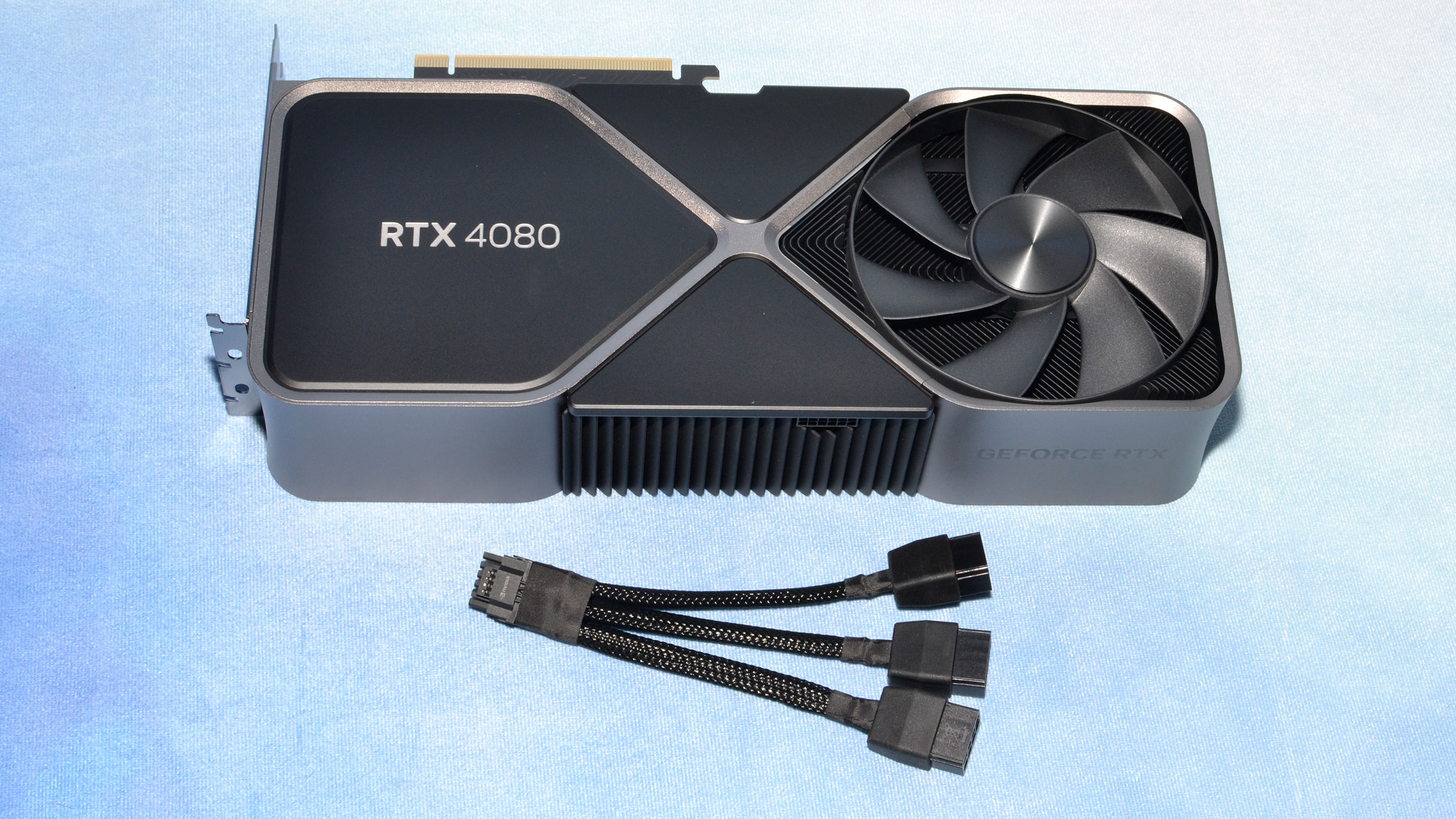Why you can trust Tom's Hardware
Nvidia's RTX 4080 Founders Edition has a lot going for it. The overall performance is great, and you can enable DLSS or some other upscaling algorithm for more demanding games. DLSS 3 holds plenty of future potential for when more games use it, and based on what we've seen from DLSS 2 over the past couple of years, we suspect plenty of games will at least give users the option to try Frame Generation.
The card is also a beast when it comes to cooling. In that sense, it's the polar opposite of the RTX 3080 Ti Founders Edition. Nvidia skimped on that card and saved the larger cooler for the 3090 and 3090 Ti, and it showed. With the 4080, Nvidia isn't making any excuses: The triple-slot cooler keeps the chip frosty, and the GDDR6X memory (rated for up to 24 Gbps, even though it runs at 22.4 Gbps) feels completely different from the first-generation GDDR6X chips used on the Ampere 3070 Ti and above.
There's so much to like about the RTX 4080 Founders Edition. There's just one problem: It's really expensive, arguably too expensive! That will be a big problem for a lot of gamers that might otherwise want the card. But all we have to do is look at what's happened so far with the RTX 4090 launch to see plenty of reasons for Nvidia to start prices on the 4080 well above $1,000.
Even though the price feels too high to us, especially in light of where the RTX 4090 sits and where AMD plans to launch the RX 7900 series, that doesn't mean everyone will refuse to pay the piper his exorbitant fees. RTX 4090 sells for over $2,000 right now, though admittedly, we lack data on how many people are actually paying that much for a graphics card. Hopefully, the early adopters have found what they needed while the rest of us wait for prices to adjust.
Put another way, the price feels like a holdover from the days when GPU mining was still viable. Ada Lovelace was created amid the worst and longest-lasting GPU shortage we've ever witnessed. The past six months have mostly erased those problems, but the 4080 is stuck with a price tag courtesy of the class of 2021.
Or maybe it's just that Nvidia and its partners have a lot of RTX 30-series GPUs they still need to sell, and they don't want to cause those prices to collapse. But if that's the case, why are RTX 3080 and 3090 cards going up in cost over the past month? I call shenanigans, and hopefully people are wise enough not to get sucked into the idea that a 3080 is worth anywhere near $800 in the current market.
Nvidia also pitches the 4080 as a replacement for the 3080 Ti, but that card was overpriced due to the aforementioned mining and supply 'perfect storm' of 2021 — and this is not a 4080 Ti. The result is a card with a name that suggests it's taking over the ostensibly $700 position occupied by the RTX 3080, only it costs 71% more. That sucks, and when Nvidia trots out an RTX 4070 Ti priced at $799 or whatever, that will be equally bad. GPUs over $1,000 used to be for the "more money than sense" Titan crowd; now they're being marketed as upper-high-end gaming cards.
Performance and power look good on their own, but the 4080 is a very poor value. On the other hand, if the RTX 4080 were an $800-$1000 card, we’d be a lot more excited … and then it would probably just sell out faster, and scalpers would end up charging $1200. So we get it, but it still stinks to see what used to be a $500–$700 model number turning into a $1200+ model. Note also that the AD102 chip is 61% larger, and the cost per die can scale quickly as size increases.
The market will ultimately decide how much people are willing to pay for the RTX 4080. Maybe Nvidia can't sell them to gamers at $1,199 or more, and short of some new cryptocoin popping up and repeating what Ethereum did, it's difficult to imagine any miners rushing out to buy 4080 cards. But Nvidia also has other aspirations, like the autonomous vehicles market and other deep learning use cases.
It still hurts to see the 4080 shooting for $1,199, though. If you can afford that, why not just go whole hog and buy an RTX 4090? Of course, we also need to see where AMD actually lands with the Radeon RX 7900 cards next month. If an RX 7900 XTX delivers better non-ray tracing performance than the 4080, and maybe the RX 7900 XT beats it as well, we'd like to think Nvidia and its partners will be forced to reconsider the pricing.
But we've been thinking that for almost two years, and it still hasn't happened. On the other hand, EVGA left the graphics card market, and looking at the RTX 4080 and RTX 4090 launches it's not difficult to find reasons to do so. Nvidia launched the RTX 3090 Ti at $1,999, an obscene price that was again influenced by cryptominers and which it couldn't maintain. When sales slumped, Nvidia slashed the price of its RTX 3090 Ti Founders Edition to $1,099 at Best Buy and its AIB partners were forced to respond. Somehow we doubt Nvidia was offering refunds for unsold 3080 and 3090 cards that could no longer command their formerly extreme prices.
The old cliche about no bad products, just bad prices, rings true once more. Even though the hardware and technology are good, $1,200 feels like too much. If the 4080 drops below $1,000, it would be much nicer; even better would be getting closer to the official RTX 30-series launch prices. It's difficult to imagine people lining up to spend this much for the "one big step down from the top" GPU, but we'll have to wait and see what happens.
And frankly, that's really what we think most people should do: Wait and see what happens next month. Few people need to go out and upgrade to a newer, faster GPU absolutely right this minute. Being first to market with an extremely powerful new architecture gives some advantages and some disadvantages. AMD has seen Nvidia's hand and can now decide how it wants to proceed.
But if you prefer Nvidia cards, or if you're interested in AI research or professional workloads like 3D rendering, $1,200 might not feel too bad at all. Admittedly, it's a lot for an awful lot for a gaming GPU, but it's downright affordable compared to professional GPUs that can cost over $5,000.
- MORE: Best Graphics Cards
- MORE: GPU Benchmarks and Hierarchy
- MORE: All Graphics Content
Get Tom's Hardware's best news and in-depth reviews, straight to your inbox.
Current page: GeForce RTX 4080: Little Sister
Prev Page GeForce RTX 4080: Power, Clocks, Temps, Fans, and Noise
Jarred Walton is a senior editor at Tom's Hardware focusing on everything GPU. He has been working as a tech journalist since 2004, writing for AnandTech, Maximum PC, and PC Gamer. From the first S3 Virge '3D decelerators' to today's GPUs, Jarred keeps up with all the latest graphics trends and is the one to ask about game performance.
-
btmedic04 At $1200, this card should be DOA on the market. However people will still buy them all up because of mind share. Realistically, this should be an $800-$900 gpu.Reply -
Wisecracker ReplyNvidia GPUs also tend to be heavily favored by professional users
mmmmMehhhhh . . . .Vegas GPU compute on line one . . .
AMD's new Radeon Pro driver makes Radeon Pro W6800 faster than Nvidia's RTX A5000.
My CAD does OpenGL, too
AMD Rearchitects OpenGL Driver for a 72% Performance Uplift : Read more
:homer: -
saunupe1911 People flocked to the 4090 as it's a monster but it would be entirely stupid to grab this card while the high end 3000s series exist along with the 4090.Reply
A 3080 and up will run everything at 2K...and with high refresh rates with DLSS.
Go big or go home and let this GPU sit! Force Nvidia's hand to lower prices.
You can't have 2 halo products when there's no demand and the previous gen still exist. -
Math Geek they'll cry foul, grumble about the price and even blame retailers for the high price. but only while sitting in line to buy one.......Reply
man how i wish folks could just get a grip on themselves and let these just sit on shelves for a couple months while Nvidia gets a much needed reality check. but alas they'll sell out in minutes just like always sigh -
chalabam Unfortunately the new batch of games is so politized that it makes buying a GPU a bad investment.Reply
Even when they have the best graphics ever, the gameplay is not worth it. -
gburke I am one who likes to have the best to push games to the limit. And I'm usually pretty good about staying on top of current hardware. I can definitely afford it. I "clamored" to get a 3080 at launch and was lucky enough to get one at market value beating out the dreadful scalpers. But makes no sense this time to upgrade over lest gen just for gaming. So I am sitting this one out. I would be curious to know how many others out there like me who doesn't see the real benefit to this new generation hardware for gaming. Honestly, 60fps at 4K on almost all my games is great for me. Not really interested in going above that.Reply -
PlaneInTheSky Seeing how much wattage these GPU use in a loop is interesting, but it still tells me nothing regarding real-life cost.Reply
Cloud gaming suddenly looks more attractive when I realize I won't need to pay to run a GPU at 300 watt.
The running cost of GPU should now be part of reviews imo.
Considering how much people in Europe, Japan, and South East Asia are now paying for electricity and how much these new GPU consume.
Household appliances with similar power usage, usually have their running cost discussed in reviews. -
BaRoMeTrIc Reply
High end RTX cards have become status symbols amongst gamers.Math Geek said:they'll cry foul, grumble about the price and even blame retailers for the high price. but only while sitting in line to buy one.......
man how i wish folks could just get a grip on themselves and let these just sit on shelves for a couple months while Nvidia gets a much needed reality check. but alas they'll sell out in minutes just like always sigh -
sizzling I’d like to see a performance per £/€/$ comparison between generations. Normally you would expect this to improve from one generation to the next but I am not seeing it. I bought my mid range 3080 at launch for £754. Seeing these are going to cost £1100-£1200 the performance per £/€/$ seems about flat on last generation. Yeah great, I can get 40-60% more performance for 50% more cost. Fairly disappointing for a new generation card. Look back at how the 3070 & 3080 smashed the performance per £/€/$ compared to a 2080Ti.Reply



